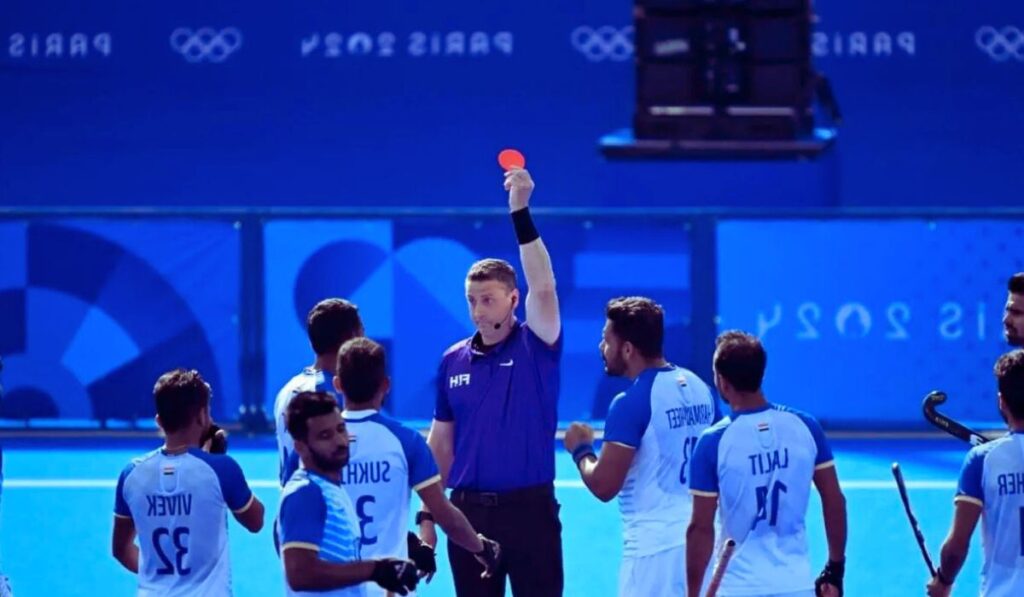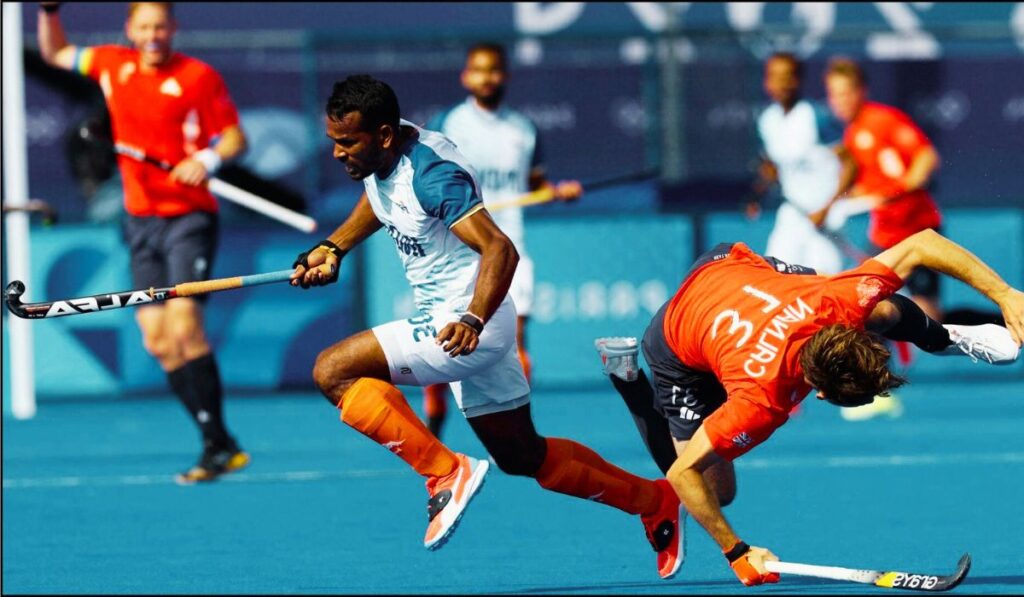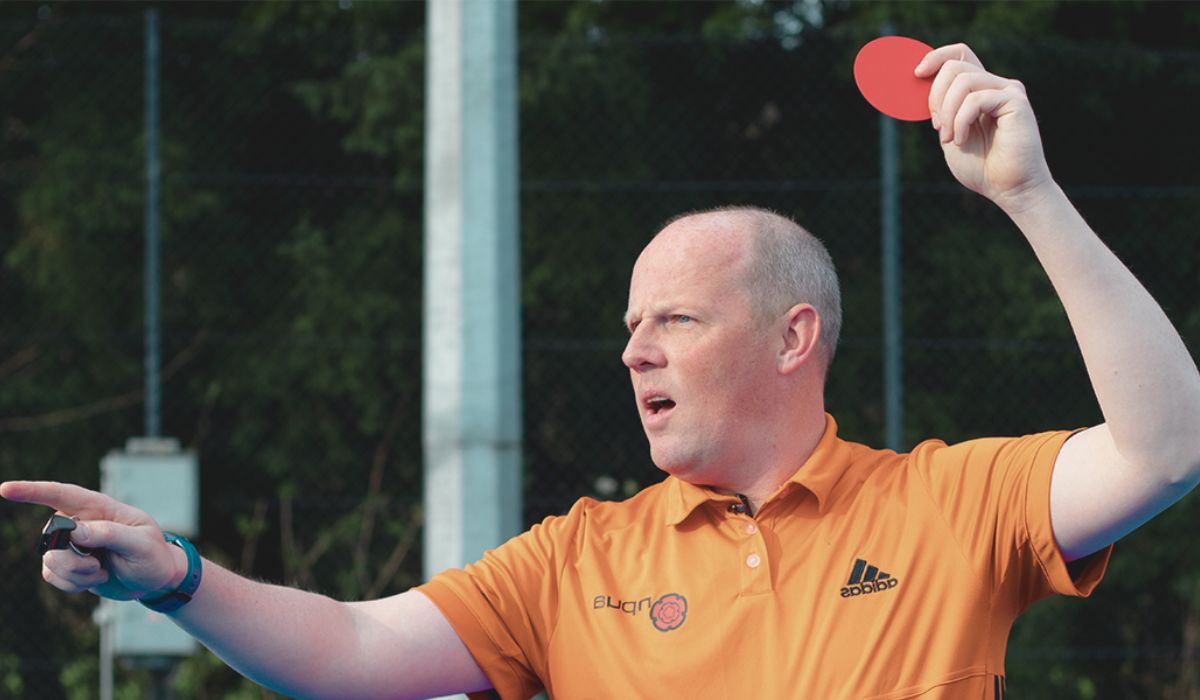A red card is the ultimate disciplinary sanction in field hockey. It signals instant ejection from the match, and the offending team must continue with one player permanently short. That loss of manpower can completely disrupt strategy, communication, and confidence. While results in frustration and regret, it also brings clarity—solidifying what boundary you must never cross if you want to stay in the game.
The Emotional Toll of Being Sent Off
Few moments in sport slice at the heart like the sight of a red card waved by an umpire. Players describe a mixture of anger, shame, and regret. They feel their team has lost, momentum is lost, and their spirit is wounded. Yet for some, it becomes a turning point—a moment of emotional clarity that makes them recommit, train smarter, and act with more discipline going forward. It’s rare, but when it becomes a lesson, it transforms regret into resolve.
What Constitutes Red Card Offences in Field Hockey
Red cards are reserved for serious infractions: violent conduct, deliberate dangerous play, racial or sexist remarks, or repeated misconduct. Unlike the occasional foul that might earn a green or yellow card, red card offences go beyond tactical errors—they represent a breach of the sport’s spirit. The umpire’s decision to issue is not just enforcement—it’s a declaration that the fundamental values of respect and safety have been violated.
How Red Cards Shift the Game’s Dynamics
When a team loses a player due to a red card, the entire game changes. Defenders must cover larger gaps, midfielders pull back to support, and attackers may retreat to help block shots. The team often shifts into a defensive shell, hoping to absorb pressure and prevent scoring. For the opposition, it becomes a chance to dominate space, keep possession, and apply relentless pressure. The game’s psychological balance swings decisively when a red card drops.

Are Red Cards Always Deserved? Controversy and Drama
Occasionally, red cards raise debate. Umpires work under pressure; human judgment is imperfect. Some send‑offs feel overly harsh—especially when contact is incidental or the match intensity led to misinterpretation. Players and fans argue. In rare cases, video reviews or umpire panels overturn decisions post-match. However, this controversy also underscores the weight of a red card in field hockey. It’s not just discipline—it’s destiny.
What Happens After a Card? Suspension and Review
Field hockey’s governing bodies enforce mandatory suspensions following red card incidents. Players may miss subsequent matches, and disciplinary panels may review the incident for further consequences. That fallout extends beyond the sending-off—it affects team selection, tournament momentum, and even sponsorship implications. in field hockey isn’t just about one match—it can delay a player’s entire season.
Coaching Response to a Any Card Incident
Good coaches use red cards as teachable moments. A well‑conducted debrief can transform embarrassment into learning. Instead of blaming the umpire, players are guided to understand what went wrong—poor timing, lack of control, or emotional escalation. They practice restraint, technique, and discipline. The next time the whistle blows in a heated play, they react with intention, not impulse. That is how red cards become silent lessons that strengthen character.
When Any Cards Ignite Team Unity
Surprisingly, losing a player can unite the remaining ten. Teams talk about playing “for the sent-off” or working harder to compensate for the absence. Captains rally spirits. A cohesive team often manages to close out tight games despite numerical disadvantage. In that sense, in field hockey becomes an emotional crucible—hurt fuelled by shared purpose and fierce determination.
Preventing Any Card Mistakes Before They Happen
Prevention matters. Players who want to avoid and learn careful tackling techniques, yard call restraint, and how to leave contact out of challenges. Visualization, breathing control, and emotional restraint training often accompany technical drills. The most disciplined players treat avoidance as essential match hygiene. They know one moment of rashness can overshadow months of hard work.
The Shockwave Moment When the Card Is Raised
It’s a moment that slices through the crowd’s chatter and players’ rhythm—the umpire’s arm lifts, the red card appears, and a hush falls. In the split second before you see it, your mind races: What did I do wrong? What will the coach say? That brief interval is where a match turns from tactical battle to emotional upheaval. A red card in field hockey doesn’t just remove a player—it strips team momentum, challenges morale, and turns strategy into survival mode in an instant.
When Discipline Clash with Passion
Field hockey is fierce by nature—tight tackles, lightning pace, emotional investment. When passion outpaces control, discipline falters. That’s often when red card incidents occur: a wild swing at the ball that catches flesh, a verbal outburst under pressure, or a reckless charge into the circle. The split-second decision to flinch or fling becomes a fiery error. The field’s regulations, spelled out in red, demand clarity amid that emotional combustion.
The High-Stakes Loss of a Teammate
Seeing a teammate walk off with a card feels like losing a limb. The hole they leave isn’t just positional—it’s emotional. Communication falters, spacing widens, and trust gets tested. Teams must reorganise quickly, reshuffle formations, and find new on-field chemistry. A red card in field hockey effectively means a shift from attack to damage control, as fewer players must carry the weight of the whole side’s ambitions.
How Umpires Decide to Issue the Cards
Umpires don’t hand out cards lightly. They consider factors like intent, force, repeated fouls, and overall spirit. A mistake is forgiven once; repeated infractions or dangerous conduct are not. They watch, they judge, then they act—often pulling out the card after a long minute of emotional escalation. It’s their way to reclaim harmony. That final gesture is more than punishment—it’s a boundary marker, defining what the sport will tolerate and what it won’t.
Recovering After Being Sent Off
When a player sits on the sideline after a red card, the psychological journey begins. Initially, there’s guilt or anger—sometimes both. Then comes self-reflection: Was it a loss of temper, a moment of fatigue, or a misjudged tackle? That emotional grappling shapes future discipline. For many, the next match becomes a redemption arc; they train harder, play smarter, and appear on the field with a quiet vow: never again.
Team Mood Shifts After Any Card Moment
The impact of a red card doesn’t stop with the individual; it reverberates through the team’s emotion. Some teams spiral—ten nervy players unsure how to fill the gap. Others galvanize. Captains fire pep talk or tactical re-alignments. Defenders step up, midfielders cover more ground, and a collective belief surfaces: adversity unites. This iron resolve—inspired by a red card in field hockey—sometimes fuels surprising comebacks.
Strategic Adjustments Once a Player Is Off
Immediately after a card, teams must rethink formations. A common shift is pulling a winger into a compact midfield to keep the center solid. Some teams deploy zonal marking across nine players rather than man-to-man. Coaches often designate a key player to distribute play wider and open space. These strategic adjustments last for the remainder of the match and often appear in training suites afterwards as case studies in adaptability.
Age Group Differences in Red Card Tolerance
Youth hockey and adult hockey treat cards differently. Juniors may receive red only in extreme cases, while adults face stricter enforcement. Young players often get more education and temporary suspensions instead of outright bans. That cautious approach helps teach lessons with care. In adult competition, however, red card rules are firm because player safety and sport integrity hold stronger weight in older divisions.
The Role of Video Review in Validating Decisions
At higher levels—national leagues and international play—video replays often confirm or overturn any card calls. That forensic review sometimes reveals marginal tackles or unlucky deflections that warrant a wrist slap instead. Video review isn’t about disarming the umpire—it’s about fairness. Still, waiting for a decision to be revisited adds tension. In such cases, a red card in field hockey rightly compels deeper scrutiny before final judgment.
Umpire Fatigue and Human Limitation
While rules are defined—two umpires, two flag men—decisions are made by humans. Mistakes happen. Umpires stand in the heat, chase play, and rely on split-second judgment. Fatigue creeps in; adrenaline drops; vision blurs. One rash call can escalate to a red card that players contest later. These realities remind everyone that discipline mechanisms are built on both precision and fallibility.
Training to Avoid Emotional Triggers
Top-level players work with sports psychologists to manage triggers—bad calls, provocation, fatigue. They practise breathing, counting, and pausing before reacting. Teams simulate red card scenarios in training—ten-on-eleven drills, penalty corner defense with a man down—to build comfort in adversity. This strategic mental training helps players remain in control long after adrenaline rises, reducing the frequency of red card in field hockey incidents born from emotional overload.
Rebuilding Team Trust After a Member is Removed
When a player is sent off, teammates must cross-train. Defenders learn to drop back, midfielders cover wider lanes, and forwards must press harder. This redistribution demands silent communication and quick alignment. Trust builds when others step up to fill the gap. If one player fails to adapt, that cracks team cohesion further. Overcoming a red card becomes a collective lesson in unity and personal responsibility.
How Any Cards Alter Tournament Momentum
In tournament formats—five-team pools or knockout stages—a red card in field hockey can shift tournament fate. One match with a poor start or disciplinary lapse can knock a team out. It’s not just about losing a match—it’s about losing tournament standing, morale, and future match readiness. Teams that blow a key match due to card turmoil often struggle to recalibrate quickly, especially in compressed schedules.
The Legacy of Any Card Moments in Player Careers
Some players carry a card as a scarlet emblem long after their playing career ends. Others wear it as a turning point. Stories abound of players who nearly walked away, only to come back stronger, disciplined, and focused. The memory of that red card fuels ambition or regret—depending on how well closure and redemption are earned afterward. For some, it becomes a badge of maturity. For others, a lesson forever etched.
Why Red Cards Demand Respect—and Wonder
Ultimately, a card in field hockey reminds players and fans that the sport values respect over recklessness. It preserves fairness, punishes misconduct, and protects safety. The emotion behind the moment—from anger to determination, shame to redemption—reveals why hockey is as much about character as about skill. A red card darkens the scoreboard and clarifies priorities—it tests whether a team falls apart or evolves stronger.
The Social Stigma Around Receiving any Card
Getting any card in field hockey doesn’t just affect gameplay—it affects reputation. Players who receive one, especially in visible matches or televised events, may feel the weight of judgment not only from opponents and fans but also from teammates, coaches, and even selection committees. Teammates may question the player’s judgment. Coaches might reconsider future starting roles. And in some cases, national selectors might take note of repeated disciplinary issues when shortlisting players for elite squads. The social aftermath is often more punishing than the card itself—because trust is far harder to win back than a scoreline.
Emotional Management During Critical Matches
High-stakes matches—finals, derbies, international clashes—carry electric tension. In such scenarios, emotions can override strategy. The adrenaline of an intense semifinal or an India-Pakistan showdown might push a player to lunge harder, yell louder, or respond to provocation faster than usual. That’s when red card moments peak. Coaches often brief players on this emotional danger, urging them to stay “ice-cold” under pressure. Managing emotional surge becomes as vital as executing passes or corners. Any card in such situations doesn’t just cost a match—it can derail a season or shatter national dreams.
Fan Reaction and Crowd Pressure After Any Card
Crowds play a dramatic role in shaping the red card atmosphere. When a any card is shown, the stadium often erupts—some cheering in glee, others booing in disbelief. The home crowd might grow aggressive, directing anger at the umpire, while the away section might mock or chant louder to demoralize the penalized team. The shift in crowd energy can impact player focus. Even calm players may feel flustered, especially when their name echoes through stadium speakers. Managing crowd noise and energy post–red card becomes a crucial test of a team’s emotional balance.
Technical Fouls That Commonly Lead to Any Cards
While violent conduct grabs headlines, many cards stem from more technical violations: repeated breakdown fouls, dangerous use of the stick, or deliberate attempts to stop a scoring opportunity (like a defender blocking a ball with the body on the goal line). Sliding tackles with no attempt to play the ball or dangerous tackles in the shooting circle are other culprits. These fouls may not appear aggressive at first glance but carry serious consequences due to the risk they pose to players. That’s why umpires issue red cards—to signal that recklessness, not just rage, has a price.
How Coaches Prepare Players to Avoid Any Card Scenarios
Elite coaches don’t just train skills—they train reactions. Teams with low card histories often incorporate decision-making drills into training: how to defend without tackling from behind, how to block space without obstructing, how to contest calls without arguing. Coaches also emphasize restraint—teaching players when to pull out of a tackle or back off during a confrontation. Match simulations with a referee present help players adjust their behavior. These training methods create players who are not only skilled with the stick but also disciplined under pressure—key to avoiding red card incidents.

The Psychological Rebound After a Red Card
The real battle often begins after the match ends. A player who’s been sent off might replay the incident in their head for days. Doubt creeps in: “Did I ruin it for everyone?” Teammates may try to offer support, but that doesn’t always soften the internal self-critique. Some athletes struggle to shake the stigma and underperform in following games. Others use the moment as fuel—diving into training, studying film, and ensuring their discipline is beyond question. That mental pivot is key. Any card in field hockey is not a career sentence—but how a player responds can define their career trajectory.
Red Cards in Women’s vs. Men’s Field Hockey
While the rules are identical, the dynamics around any cards can differ between men’s and women’s matches. Men’s games tend to feature more physical play, often resulting in red cards due to stick clashes, body collisions, or aggressive pressing. Women’s matches, by contrast, often issued for persistent fouling or dissent. This isn’t about strength or skill—it’s about game rhythm and tempo. Analysts who study card patterns note these subtle differences and use them to tailor team preparation. Understanding gender-based tendencies in gameplay helps predict and prevent disciplinary risks.
The Legacy of Iconic Red Card Moments in History
Over the decades, certain any card moments have become part of field hockey folklore. A famous one occurred during a tight Olympic semifinal, where a captain was sent off for retaliating after a tackle—costing his team a shot at gold. Another occurred in a Champions Trophy final, when a rising star lashed out under provocation, only to be benched for months by the national board. These stories echo through training camps and locker rooms, passed down as cautionary tales. The lesson is clear: one moment of recklessness can undo years of hard-earned progress.
The Final Takeaway on Red Cards in Field Hockey
Any card in field hockey is not just punishment—it’s a symbol. It represents misconduct, pressure mismanagement, and a failure to uphold the sport’s values. Yet it can also mark a turning point—a moment where a player or team re-evaluates, adjusts, and emerges stronger. Understanding the rules, emotional weight, and game impact helps reduce recurrence. Red cards hockey should never define a career, but they can refine a player’s mindset—and that is where real growth begins.


3 thoughts on “When a Red Card in Field Hockey Can Elevate or Crush Your Spirit”